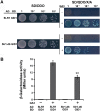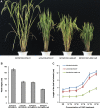Characterization of a new semi-dominant dwarf allele of SLR1 and its potential application in hybrid rice breeding
- PMID: 29955878
- PMCID: PMC6137977
- DOI: 10.1093/jxb/ery243
Characterization of a new semi-dominant dwarf allele of SLR1 and its potential application in hybrid rice breeding
Abstract
The widespread introduction of semi-dwarf1 (sd1), also known as the 'Green Revolution' gene, has dramatically increased rice yield. However, the extensive use of limited sources of dwarf genes may cause 'bottleneck' effects in breeding new rice varieties. Alternative dwarf germplasms are quite urgent for rice breeding. Here, we characterized a new allele of the rice Slr1-d mutant, Slr1-d6, which reduced plant height by 37%, a much milder allele for dwarfism. Slr-d6 was still responsive to gibberellin (GA) to a reduced extent. The mutation site in Slr1-d6 was less conserved in the TVHYNP domain, leading to the specific semi-dominant dwarf phenotype. Expression of SLR1 and five key GA biosynthetic genes was disturbed in Slr1-d6, and the interaction between Slr1-d6 and GID1 was decreased. In the genetic background of cultivar 9311 with sd1 eliminated, Slr1-d6 homozygous plants were ~70 cm tall. Moreover, Slr1-d6 heterozygous plants were equivalent in height to the standard sd1 semi-dwarf 9311, but with a 25% yield increase, showing its potential application in hybrid rice breeding.
Figures







Similar articles
-
Generation and Transcriptome Profiling of Slr1-d7 and Slr1-d8 Mutant Lines with a New Semi-Dominant Dwarf Allele of SLR1 Using the CRISPR/Cas9 System in Rice.Int J Mol Sci. 2020 Jul 31;21(15):5492. doi: 10.3390/ijms21155492. Int J Mol Sci. 2020. PMID: 32752068 Free PMC article.
-
Isolation and characterization of dominant dwarf mutants, Slr1-d, in rice.Mol Genet Genomics. 2009 Feb;281(2):223-31. doi: 10.1007/s00438-008-0406-6. Epub 2008 Dec 9. Mol Genet Genomics. 2009. PMID: 19066966
-
Characterization of the molecular mechanism underlying gibberellin perception complex formation in rice.Plant Cell. 2010 Aug;22(8):2680-96. doi: 10.1105/tpc.110.075549. Epub 2010 Aug 17. Plant Cell. 2010. PMID: 20716699 Free PMC article.
-
Making the 'Green Revolution' Truly Green: Improving Crop Nitrogen Use Efficiency.Plant Cell Physiol. 2021 Sep 30;62(6):942-947. doi: 10.1093/pcp/pcab051. Plant Cell Physiol. 2021. PMID: 33836084 Review.
-
The genetic and molecular basis of crop height based on a rice model.Planta. 2018 Jan;247(1):1-26. doi: 10.1007/s00425-017-2798-1. Epub 2017 Nov 6. Planta. 2018. PMID: 29110072 Review.
Cited by
-
The Role of Dwarfing Traits in Historical and Modern Agriculture with a Focus on Rice.Cold Spring Harb Perspect Biol. 2019 Nov 1;11(11):a034645. doi: 10.1101/cshperspect.a034645. Cold Spring Harb Perspect Biol. 2019. PMID: 31358515 Free PMC article. Review.
-
The mutation of ent-kaurene synthase, a key enzyme involved in gibberellin biosynthesis, confers a non-heading phenotype to Chinese cabbage (Brassica rapa L. ssp. pekinensis).Hortic Res. 2020 Nov 1;7(1):178. doi: 10.1038/s41438-020-00399-6. Hortic Res. 2020. PMID: 33328441 Free PMC article.
-
A point mutation resulting in a 13 bp deletion in the coding sequence of Cldf leads to a GA-deficient dwarf phenotype in watermelon.Hortic Res. 2019 Dec 1;6:132. doi: 10.1038/s41438-019-0213-8. eCollection 2019. Hortic Res. 2019. PMID: 31814985 Free PMC article.
-
Mapping and molecular marker development for the BnaSBT gene controlling inflorescence and plant architectures in B. napus.Mol Breed. 2025 Apr 15;45(4):45. doi: 10.1007/s11032-025-01556-2. eCollection 2025 Apr. Mol Breed. 2025. PMID: 40247998
-
Analysis of the Candidate Genes and Underlying Molecular Mechanism of P198, an RNAi-Related Dwarf and Sterile Line.Int J Mol Sci. 2023 Dec 22;25(1):174. doi: 10.3390/ijms25010174. Int J Mol Sci. 2023. PMID: 38203344 Free PMC article.
References
-
- Asano K, Hirano K, Ueguchi-Tanaka M, Angeles-Shim RB, Komura T, Satoh H, Kitano H, Matsuoka M, Ashikari M. 2009. Isolation and characterization of dominant dwarf mutants, Slr1-d, in rice. Molecular Genetics and Genomics 281, 223–231. - PubMed
-
- Asano K, Takashi T, Miura K, Qian Q, Kitano H, Matsuoka M, Ashikari M. 2007. Genetic and molecular analysis of utility of sd1 alleles in rice breeding. Breeding Science 57, 53–58.
-
- Chomczynski P, Mackey K. 1995. Short technical reports. Modification of the TRI reagent procedure for isolation of RNA from polysaccharide- and proteoglycan-rich sources. Biotechniques 19, 942–945. - PubMed
-
- Davière JM, Achard P. 2013. Gibberellin signaling in plants. Development 140, 1147–1151. - PubMed
Publication types
MeSH terms
Substances
LinkOut - more resources
Full Text Sources
Other Literature Sources

